The Blue Bell Legend
by Larry Larned
Reprinted from "INSULATORS - Crown Jewels of the Wire", July 1978, page 10
Much interest has been shown recently in porcelain telephone signs --
particularly those formerly used by the Bell System -- also known collectively as
AT&T. I have collected blue bell signs almost as long as I have collected
insulators, and each complements the other.
The use of a blue bell as a legend
to denote Bell System affiliation is an interesting story; and, as I recently
discovered, the blue bell isn't always blue. More on this point later. The
formation of AT&T in 1885 was no accident; and, as many investors know
today, it has become the most widely held stock in the U.S. The detailed events
leading up to the formation of AT&T are complex and I don't believe
necessarily relevant here. However, a brief outline of the events is interesting and sheds some light on the blue bell symbol.
The formation of
AT&T came about as a result of problems in capitalization by the American
Bell Telephone Company, a Massachusetts corporation. American Bell was the
parent company of many smaller companies operating local exchanges using Bell
invented equipment. The commercial failure of the New York-Boston long distance
line in 1884, caused by a conflict of territorial rights between the New England
Telephone & Telegraph Company, the Metropolitan Telephone and Telegraph
Company (now New York Telephone) and the Southern New England Telephone Company,
all of which operated local exchange service but had an interest in long line
service, led to a decision by American Bell that if the development of long lines
was to proceed properly, a special subsidiary company had to be formed and
financed for overseeing long distance service.
American Bell petitioned the
Massachusetts legislature early in 1885 for permission to increase the
capitalization of the American Bell Company from $10,000,000 to $30,000,000.
This request was refused, and American Bell sought incorporation of its
subsidiary, AT&T, outside of Massachusetts. As a consequence, a new
company was formed and chartered in New York on February 28, 1885, under the
title of the American Telephone and Telegraph Company. Its sole purpose was to
build, maintain and construct telephone lines all over the North American
continent and to connect existing and future companies with each other by means
of long lines. For this reason AT&T was called the Long Distance Company.
Its original capitalization was $100,000. Its first president was Theodore N.
Vail, and its first general superintendent was Angus S. Hibbard. AT&T began
life as a small subsidiary company of American Bell Telephone, and it was not
until many years later (1899) that it achieved the powerful position which it
now enjoys. This also explains why insulators embossed AT&T are of the toll
variety. They were produced to satisfy the needs of the Long Distance Company
and to distinguish its lines from those of other companies sharing the same
poles.
Work on developing a meaningful standardized service mark for the Long
Distance Company began in 1888 by General Superintendent Angus Hibbard after the
company had established 550 miles of pole lines to connect the numerous local
exchange companies in the American Bell Telephone System. The consideration in
developing a suitable sign or advertisement for telephone service was directed
toward a meaningful symbol; and it was felt that, as Dr. Alexander Graham Bell
had invented the telephone, and the parent company of AT&T was the American
Bell Telephone Company, the use of the Bell for a telephone sign was symbolical.
The Liberty Bell was used as a foundation, and the first sketch submitted by
Hibbard displayed a winged bell with the words "Long Distance
Telephone" on the bell.
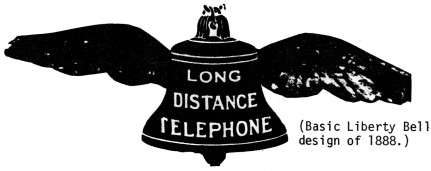
The idea of using wings was to indicate the flight or speed of telephone
transmission. However, this was considered too fanciful; and, after further
consideration, the wings were cut off. Thus the basic sign was born, much as we
know it today. Interestingly enough, the bell symbol was not copyrighted. An
effort was made to copyright the sign, but it was not possible, because a fish
dealer in Boston was using a similar sign for his business! (Perhaps he was the
originator.) I suppose in those days the possibility of buying up the fish
business and its bell sign was either unthinkable or not economically feasible.
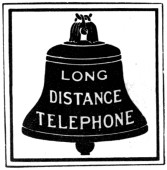
Basic sign used from 1888 to 1895.
Some may still be in service!
The blue bell sign with the words "Long Distance Telephone" was
used almost for the first time in Wrentham, Massachusetts, where a public
station had been established in the autumn of 1888. The Long Distance Company,
which held a franchise in Wrentham, looped a pair of wires from the
Providence-Boston Line into a drug store. A blue bell sign was hung out in front
of the store. Within a short period of time, the blue bell was adopted by all
associated companies throughout the U.S. and in parts of Canada.
The first documented use of the sign used indoors was in a Southern New
England Telephone Company building located in New Haven, Connecticut, during
March 1889. Blue bell signs were attached to double-walled booths which offered
public pay stations. A letter still preserved in the Southern New England
Telephone Archives, dated August 17, 1888, signed by Angus Hibbard, offers
"iron enamel signs" bearing the blue bell symbol. As mentioned
earlier, the first blue bell signs bore the message "Long Distance
Telephone" and were used only at stations of the Long Distance Company.
After a while, perhaps five years or so, when the signs were in general use, the
word "local" was added to the legend. The sign then accommodated
AT&T providing long distance service, plus the local exchange company
providing local service.
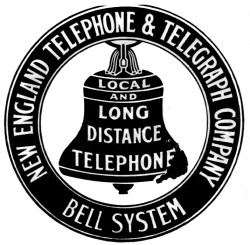
A sign which is notable in this respect is a New England
Telephone and Telegraph Company sign which consists of the blue bell with
"Local and Long Distance Telephone" within a blue circular band or
wreath. The bell has a complete hanger assembly from the circular band and a
white background. On the top half of the band in white letters is written
"New England Telephone and Telegraph Company". On the lower half of
the band is written "Bell System". My guess is that this sign (shown
above), which dates from 1895, was a transition sign, word "Local",
before the major design change in 1900.
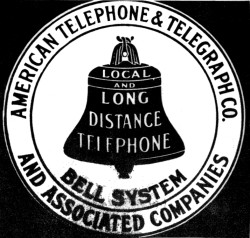
The events which led up to the 1900 design change (shown above) were
monumental in terms of the Bell System's future. In 1899 American Bell Telephone
Company voted to transfer all of its assets to American Telephone and Telegraph
Company. Headquarters of the new organization were subsequently established in
New York. The actual exchange of stock took place in May of 1900. Thus the major
design change of 1900, with the wording "American Telephone and Telegraph
Company" on the top half of the band, and "And Associated
Companies" on the lower half of the band. The words "Bell System"
appeared in the white field below the bell. (The Associated Companies sign of
1900 was still in service during 1977 before becoming a member of my sign
collection!)
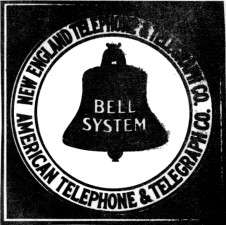
The American Bell Telephone Company was not dissolved by decree until
December 16, 1921. Again, a changed blue bell sign (shown above). This time the
wording "Bell System" replaced the words "Local and Long Distance
Telephone", and the name of the associated local company was placed on the
top half of the band) and the words "American Telephone & Telegraph
Company" were placed on the lower half of the band.
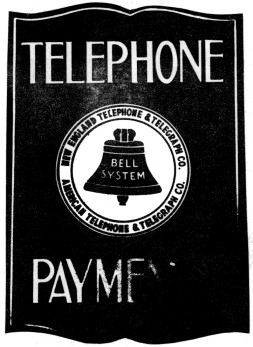
Other changes have taken place over the years since 1921, which have modified
the shape of the bell and the message to be conveyed by the trademark. These
changes have progressed to a modern looking logo which has some resemblance to
the original blue bell sign.
(Above is a New England Telephone and Telegraph Company sign, circa 1938,
formerly used to advertise phone bill payment agencies.)
Since there are always exceptions to the rule, blue bells are no exception,
either. My sign collection includes a New England Telephone & Telegraph Co.
sign with a white bell. It is 1938 vintage and colonial in shape. (See following
page.) I have another like it identical in every way except that the bell is
blue.
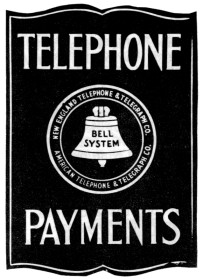
The "white bell" sign, also 1938 vintage.

The Modern Logo
Southern New England Telephone Company Sign
Will the blue bell survive? This is a question that only time will tell.
However, it has survived many changes and represents one of the longest lasting
service marks in American history.
| 